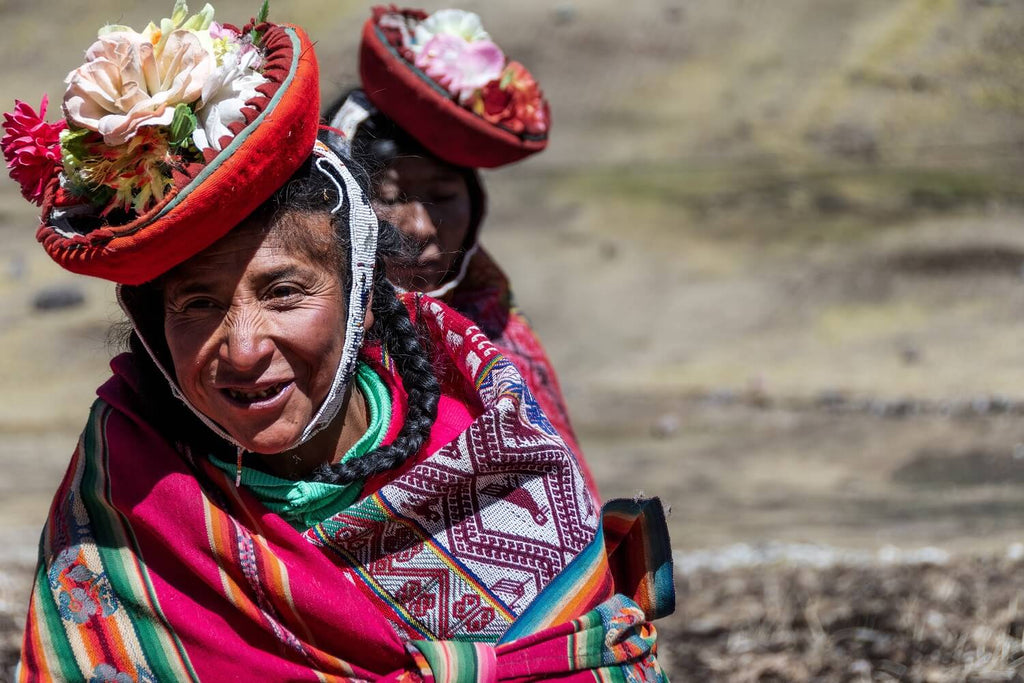In our three-part blog series, we look at the Three Pillars of Sustainability: environmental, economic and social and how they can be incorporated into “sustainable fashion”. Below is Part III: Social Aspects of Sustainability.
The social, environmental and economic aspects of sustainability are interdependent – you can’t have true sustainability if you sacrifice one of these pillars in the name of supporting another.

Juana Rios, the current president of the Ticllay Warmi weaving association in Chaullacocha. Photo by: Eric Mindling.
Lack of access to quality economic opportunities is a real issue facing many rural indigenous Andean communities in Peru. Some people emigrate to urban areas in search of work but this is no real solution. An individual or a family might see some short-term economic gain, but in the process, they give up their way of life, their connection to their community and their heritage, and in many cases quality of life is actually reduced as people go from being landowners to renters in shanty villages.

A woman plays with her baby in Upis, near Ausangate. Photo by: Mariah Krey.
In this final installment of our three-part blog series, we’ll look at the social aspects of sustainability, and how working with artisans provides a net social benefit to women, their families and their communities in the rural highlands of Peru.
-
Part I – the Environmental aspects of sustainability
-
Part II – the Economic aspects of sustainability
Women’s Empowerment
The vast majority of artisans we work with – 94% – are women. With household and community responsibilities, it is especially difficult for women to seek paid work outside the home. Instead, weaving is a really great home-based activity that women can do to earn their own source of income.

Justina works at her loom in Rumira Sondormayo, among the other members of the Puka Turpay weaving association. Photo by: Eric Mindling.
Working as artisans with Threads of Peru not only provides women their own source of income, but also instils pride in themselves, their skills and their heritage. The women in the associations we work with have an opportunity to develop leadership skills which can earn them greater respect within their family and community, and their renewed self-confidence may inspire them to pursue more opportunities for themselves.

Demesia proudly shows off her work on the Chaska baby alpaca poncho in her home community of Chaullacocha. Demesia has held several positions in her weaving association, including Secretary and Treasurer.
Furthermore, studies have shown that when women earn their own income, the health and well-being of their children improve at a greater rate than when men have sole control of the family income. In our case, income from weaving supports a collective total of over 300 children of school age or younger as the weavers tell us that they use their additional income to invest in better nutrition, education and living conditions.

Little girls play together during a weaving meeting in Upis. Photo by: Mariah Krey.
Educating the Global Community
Education is a key part of what we do. We want people to understand and appreciate the work that goes into making the products we sell, and the richness of their cultural value. Through blogs, social media and the occasional presentation, we also aim to spread awareness about values of sustainability and conscious consumerism.
Protection of Traditional Culture
Like so many traditional cultures the world over, Andean culture in Peru faces the dual pressures of cultural degradation and lack of economic opportunities. Our business model brings needed income to rural families without diminishing the fabric of the traditional Andean lifestyle, breathing new life into this centuries-old culture.

The Andes has a rich culture, filled with deep respect for people and the natural world. Photo by: Lizz Giordano.
Threads of Peru products represent the work and the heritage of over 120 artisans in seven communities within four regions of Cusco, each region with its own distinct textile traditions and techniques. Everything is made by hand using traditional backstrap loom weaving and spinning techniques that date back thousands of years.

Narcisa, a member of the Mayu Chaska weaving association in Pitukiska, works on a Tawa pillow in Coral, in her home in nearby Amparaes. Narcisa is one of the weavers who learned the discontinuous warp technique from elders including her mother-in-law, Jacinta. Photo by: Ligia Gomez.
Threads of Peru aims to incorporate complex techniques into the products we make. The TAWA alpaca pillow from our 2018 Collection is a clear example of this effort. It features discontinuous warp and weft weaving – a technique that is very challenging and practiced by only a few.

The Tawa alpaca throw pillow, in Coral, on the loom. Photo by: Ligia Gomez.
In fact, in order to produce it, the weavers in the community where it is made had to reconnect with their elders in order to learn it. This is exactly what we’re all about. The name comes from Tawantinsuyu, the Quechua name for the Incan Empire; “tawa” also means “four” in the Quechua language, and in this design, refers to the four quadrants of this throw pillow.

Fun with the finished Tawa alpaca throw pillow. Our pillows are sewn up by husband-and-wife team, Armando & Josefina, in Chinchero. Photo by: Anna Watts.
Did you miss the first two parts of our three-part series on sustainability? Check them out below:

